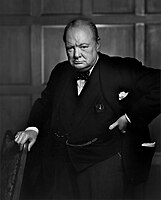Our website is made possible by displaying online advertisements to our visitors.
Please consider supporting us by disabling your ad blocker.
Churchill war ministry
Churchill war ministry | |
|---|---|
| 1940–1945 | |
 Churchill, The Roaring Lion, 1941 | |
| Date formed | 10 May 1940 |
| Date dissolved | 23 May 1945 |
| People and organisations | |
| Monarch | George VI |
| Prime Minister | Winston Churchill |
| Deputy Prime Minister | Clement Attlee (1942–1945) |
| Total no. of members | 223 appointments |
| Member parties | |
| Status in legislature | Supermajority (unity government) 604 / 615 (98%)
|
| History | |
| Legislature term | 1935–1945 |
| Incoming formation | Norway Debate |
| Predecessor | Chamberlain war ministry |
| Successor | Churchill caretaker ministry |
The Churchill war ministry was the United Kingdom's coalition government for most of the Second World War from 10 May 1940 to 23 May 1945. It was led by Winston Churchill, who was appointed prime minister of the United Kingdom by King George VI following the resignation of Neville Chamberlain in the aftermath of the Norway Debate.
At the outset, Churchill formed a five-man war cabinet which included Chamberlain as Lord President of the Council, Clement Attlee as Lord Privy Seal and later as Deputy Prime Minister, Viscount Halifax as Foreign Secretary, and Arthur Greenwood as a minister without portfolio. Although the original war cabinet was limited to five members, in practice they were augmented by the service chiefs and ministers who attended the majority of meetings. The cabinet changed in size and membership as the war progressed but there were significant additions later in 1940 when it was increased to eight after Churchill, Attlee, and Greenwood were joined by Ernest Bevin as Minister of Labour and National Service; Anthony Eden as Foreign Secretary, replacing Halifax who was sent to Washington as Ambassador to the United States; Lord Beaverbrook as Minister of Aircraft Production; Sir Kingsley Wood as Chancellor of the Exchequer; and Sir John Anderson as Lord President of the Council, replacing Chamberlain who died in November (Anderson later became chancellor after Wood's death in September 1943).
The coalition was dissolved in May 1945, following the final defeat of Germany, when the Labour Party decided to withdraw in order to prepare for a general election. Churchill, who was the leader of the Conservative Party, was asked by the King to form a new, essentially Conservative, government. It was known as the Churchill caretaker ministry and managed the country's affairs until the completion of the general election on 26 July that year.
Previous Page Next Page


